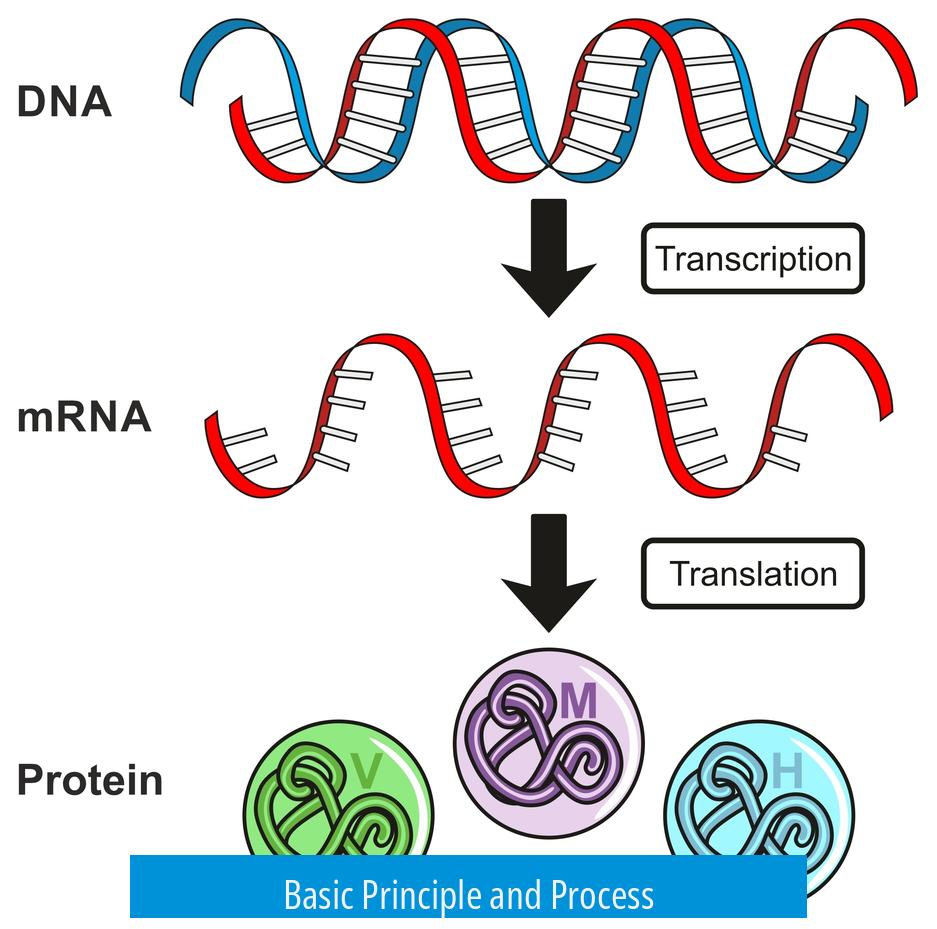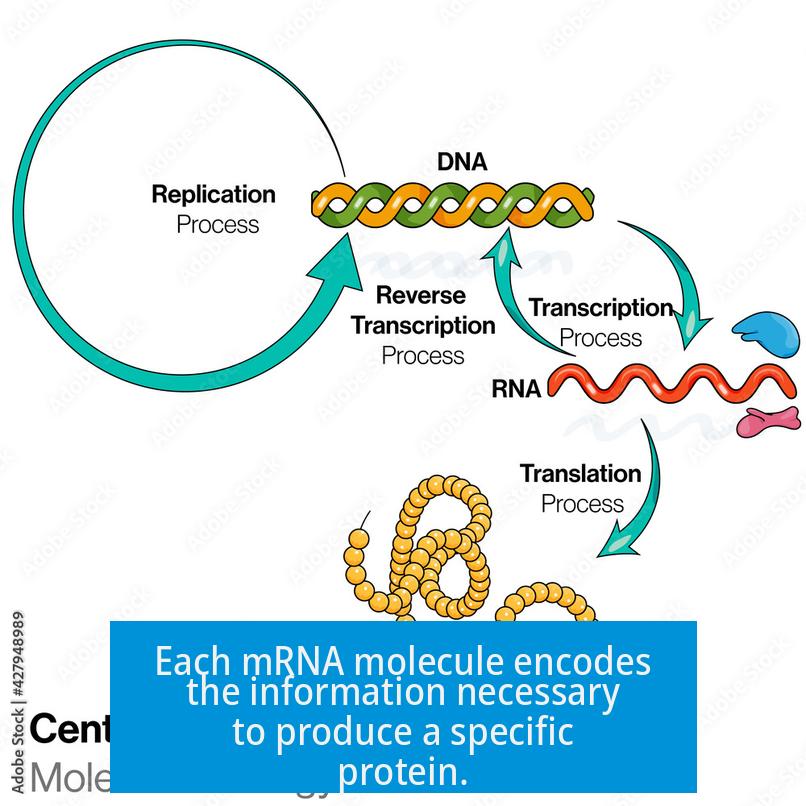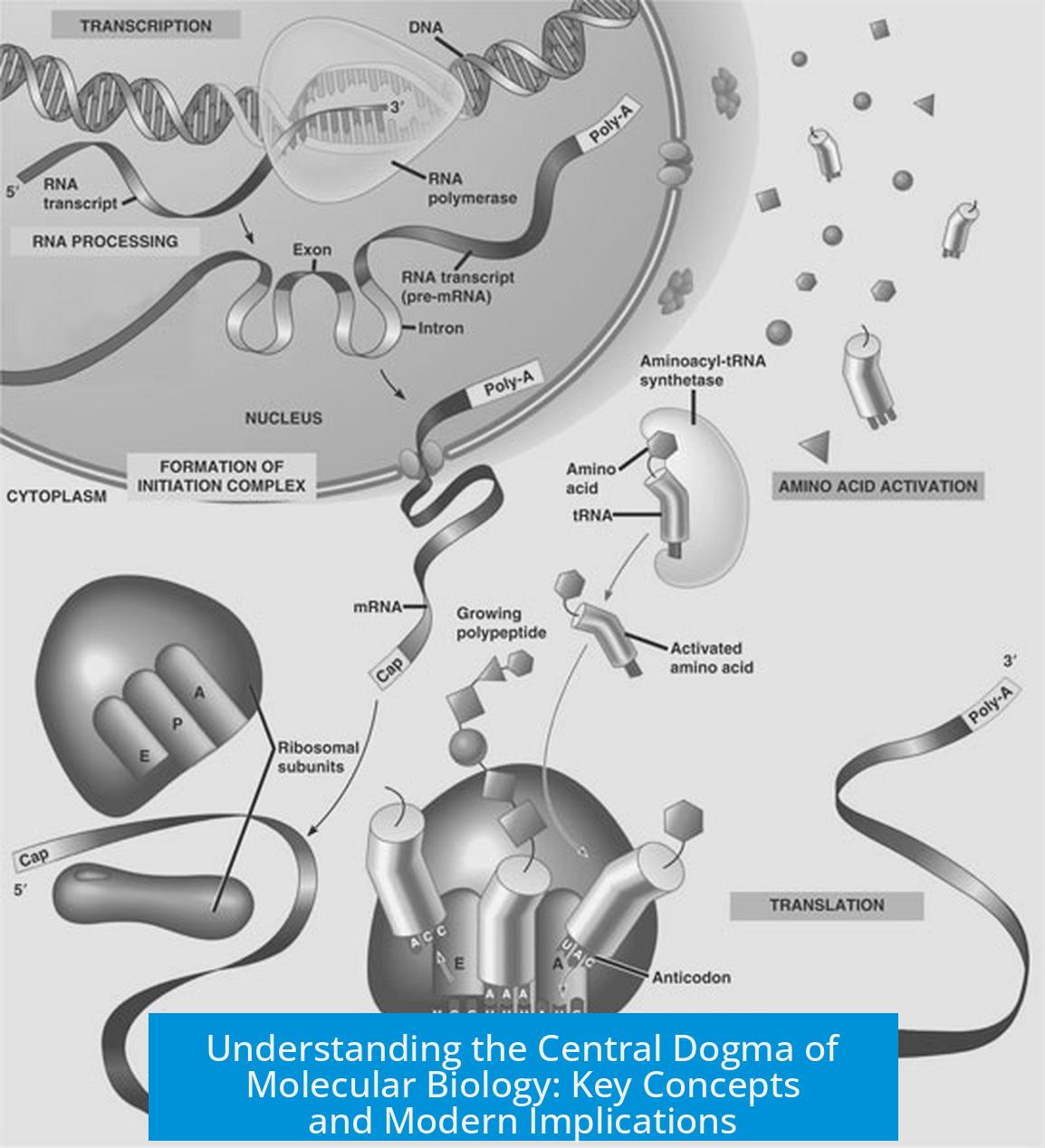Understanding the Central Dogma of Molecular Biology

The central dogma of molecular biology is the process in which genetic information flows from DNA to RNA to protein. It describes how the instructions in genetic material guide the production of proteins, which perform various functions in living cells. This concept provides a foundational understanding of gene expression and protein synthesis.
Basic Principle and Process

The central dogma explains the directional flow of genetic information. DNA, which stores the genetic code, is transcribed into messenger RNA (mRNA). The mRNA then carries this code to ribosomes where it directs the assembly of amino acids into proteins—a process called translation. These proteins carry out most cellular activities.
- Transcription: DNA → RNA (specifically mRNA).
- Translation: RNA → Protein.
Each mRNA molecule encodes the information necessary to produce a specific protein.

Historical Origin and Francis Crick’s Role
The theory was proposed by Francis Crick in the late 1950s. Crick described the central dogma as detailing the transfer of sequence information between nucleic acids and proteins. His original statement emphasized that information could not transfer backward from proteins to nucleic acids or other proteins.
Crick viewed the central dogma as a fundamental assumption rather than an absolute law. He predicted the existence of small molecules to transport amino acids to ribosomes and foresaw the use of gene sequences to study evolution, revolutionizing biological classification.
Common Misconceptions and Clarifications
A widespread but oversimplified interpretation holds that information flows strictly from DNA to RNA to protein. However, this excludes some biological processes and exceptions. The central dogma does not deny the transfer of information from RNA back to DNA or DNA to DNA, which occurs in nature.
The “one-way street” idea, common in textbooks, is a simplification. The original dogma strictly prohibits only the transfer of information from proteins back to nucleic acids or other proteins.
Oversimplification vs. Original Theory
- Many definitions erroneously exclude reverse information flow from RNA to DNA, a process observed in retroviruses.
- Crick’s full theory allows for information transfer between DNA and RNA in both directions but forbids protein-to-nucleic acid information transfer.
Exceptions and Revisions to the Central Dogma
The central dogma holds generally true but admits specific exceptions:
Reverse Transcription
Retroviruses, such as HIV, transfer genetic information from RNA back to DNA. This process, called reverse transcription, uses the enzyme reverse transcriptase. Crick predicted and included this possibility in his theory.
Prions
Prions are misfolded proteins that induce other proteins to misfold similarly, propagating this altered state without nucleic acids. They replicate via protein conformation change rather than genetic information flow. As prions lack nucleic acid material, they lie outside the cellular context of the central dogma.
Cellular Focus and Importance of Exceptions
The central dogma specifically pertains to cellular life forms where genetic information flows between DNA and RNA and from RNA to protein. Retroviruses and prions, although biologically relevant, are not cellular life and represent exceptions rather than contradictions to the dogma.
Educational Importance and Conceptual Usefulness
The central dogma remains a crucial educational tool and conceptual guide. It helps students and researchers understand the fundamental flow of genetic information and pinpoint where issues arise in protein production.
For example, if a protein is not expressed:
- Check for mRNA presence to determine if translation is faulty.
- If mRNA is absent, suspect a transcription problem.
Though simplistic, the dogma provides a reliable framework to approach molecular biology problems before exploring complex regulatory pathways and exceptions.
Metaphorical Analogy
The central dogma can be metaphorically described as:
- DNA: The programmer that holds the code.
- RNA: The programming instructions.
- Amino acids: The programming language.
- Proteins: The final program.
- Cell: The computer executing the program.
This analogy clarifies the sequential and functional nature of genetic information flow.
Central Dogma and Modern Genetic Medicine
The dogma underpins much of current genetic medicine. It informs intervention strategies for genetic disorders through:
- Gene therapy—to correct DNA defects.
- Gene switching—to control gene expression levels.
- RNA splicing manipulation—to alter mRNA processing and protein products.
Genetic medicine relies on the logic that sequence information flows to proteins and that modifying the nucleic acid sequence can change protein outcomes and cell behavior.
Enduring Applicability
Despite emerging complexities in molecular biology, no genetic medicine has disproven the fundamental assumption of the central dogma. The concept remains central to understanding genetic diseases, protein synthesis, and cell function.
Summary of Key Points
- The central dogma states genetic information flows from DNA to RNA to protein.
- Originated by Francis Crick, the theory prohibits information flow from proteins to nucleic acids.
- It is a generalization and does not exclude known exceptions like reverse transcription and prion propagation.
- The dogma serves as a foundational teaching tool to understand molecular biology and gene expression.
- Reverse transcription and prions represent exceptions outside typical cellular processes.
- The concept informs modern genetic therapies and medicine.
- Understanding the dogma helps troubleshoot issues in protein expression and gene regulation.
Demystifying the Central Dogma: The Blueprint of Life with a Twist
First off, what exactly is the Central Dogma? In plain terms, it’s the principle that genetic information flows from DNA to messenger RNA (mRNA), and then to proteins. This flow spells out how cells make the proteins that run our bodies. Simple, right? But here’s the catch—the story is richer and more complex than the textbook soundbite.
Let’s unpack this biological bestseller, from its original script penned by Francis Crick to the colorful plot twists discovered later.
From DNA to Protein: The Central Dogma in a Nutshell
The central dogma states that DNA holds our genetic instructions. These instructions are transcribed into mRNA. Then, this mRNA is translated into proteins, which perform countless tasks in the cell. In essence, DNA is the original recipe book, mRNA the chef’s notes, and proteins the final dish.
Practically, this model helps scientists troubleshoot gene expression. If a protein isn’t showing up in the lab, a quick look at mRNA levels can reveal if the issue lies in transcription or translation. This “rule of thumb” is handy but deliberately simplified. It doesn’t cover every twist and turn of RNA biology or all forms of transcription activity, making it more of a helpful guideline than a full roadmap.
The Man Behind the Dogma: Francis Crick’s Original Vision
In the late 1950s, Francis Crick introduced the central dogma as a way to describe the flow of sequential information in molecules. Contrary to popular belief, Crick’s original definition focuses on what cannot happen—specifically, that information does not flow backward from protein to protein or protein to nucleic acid. He made no claims eliminating DNA replication or RNA-to-DNA information transfer, which are part of normal cellular processes.
This nuance is often lost. Later simplifications, notably one attributed to James Watson, wrongly assert a strict one-way flow of information as gospel. These oversimplified versions don’t reflect Crick’s thoughtful refinement or the full biological reality.
Exception to the Rule? Not So Fast
Biology loves exceptions. Retroviruses can convert RNA back into DNA through reverse transcription, something Crick anticipated. Prions, oddballs that propagate by changing the shape of normal proteins (rather than using nucleic acids), also challenge simplistic views, though they’re not considered cellular life and don’t violate the dogma at its core.
Despite these special cases, the central dogma remains a useful generalization. It sets the framework for understanding gene expression while acknowledging that nature’s creative license means every rule has its exceptions.
Why Should We Care? The Practical Magic of the Central Dogma
Is the central dogma just a high school lesson nugget? Not really. Think of it as a foundational theme in biology. Like learning to walk before running, it’s a concept that underpins everything from evolutionary studies to cutting-edge genetic medicine.
For example, modern gene therapy exploits this knowledge. By inserting or silencing genes, scientists can alter the mRNA or protein production steps to correct diseases. Knowing where the information flow breaks down helps pinpoint potential intervention points—whether it’s fixing transcription errors or meddling with RNA splicing.
Think of It Like a Computer
If you prefer tech metaphors: think of DNA as the programmer writing code, mRNA as that code in a readable programming language, amino acids as the language’s building blocks, proteins as the final program, and the cell as the computer running it all. This analogy breaks down a complex biological process into a relatable framework.
But beware, just like any computer, cells come with bugs, patches, and occasional unexpected updates (hello, epigenetics and regulatory RNAs) that add layers far beyond the classic flow.
Crick’s Central Dogma and Today’s Genetic Adventures
Decades after Crick’s seminal work, the central dogma still forms the backbone of molecular biology. Researchers today use its principles to trace evolutionary relationships between species or develop genetic engineering tools. The theory hasn’t been overturned by any genetic medicine; instead, most therapies work within its framework.
It also guides how scientists interpret laboratory data. When things go haywire, such as a missing protein or faulty gene expression, the central dogma acts like a detective’s map to solve the molecular mystery.
Summary Table: Central Dogma Essentials
| Aspect | Fact / Insight | Why It Matters |
|---|---|---|
| Original Concept | Information flows from DNA → RNA → Protein, no backflow from protein | Establishes the direction of genetic information transfer |
| Common Misconception | One-way flow is absolute & no information flow back to DNA or RNA | Oversimplifies and misconstrues Crick’s nuanced theory |
| Exceptions | Retroviruses use reverse transcriptase; prions propagate without nucleic acids | Shows biology’s complexity; central dogma is a useful, not absolute, rule |
| Application | Used in genetics, evolutionary biology, gene therapy, and research diagnostics | Essential for understanding and manipulating gene expression and disease |
Questions to Ponder
- How does understanding the central dogma help in designing new therapies for genetic diseases?
- Given the exceptions, how might the definition evolve with future discoveries?
- Can the central dogma concept extend beyond classical biology into synthetic biology and bioengineering?
As you journey deeper into molecular biology, keep the central dogma close—not as an unbreakable law but as a compass pointing toward understanding life’s processes. And remember: *biology is rarely straightforward, but that’s what makes it so fascinating.*
What exactly did Francis Crick mean by the Central Dogma?
Crick’s Central Dogma states that information cannot transfer from protein back to DNA or RNA. It allows DNA to copy itself and RNA to be made from DNA but forbids protein to change nucleic acids.
Is the Central Dogma a strict one-way process in cells?
Not strictly. While DNA → RNA → Protein is the main flow, RNA can reverse-transcribe into DNA, such as in retroviruses. Crick acknowledged these exceptions.
Why is the common version of the Central Dogma oversimplified?
The popular version ignores DNA and RNA copying steps and wrongly claims information always flows one way. Crick’s original idea focused on no protein-to-nucleic acid info transfer.
How does the Central Dogma help when studying protein expression problems?
It guides troubleshooting. If a protein does not appear, check if mRNA is present. No mRNA means a transcription problem; if mRNA exists, the issue lies in translation.
Why is the Central Dogma still important despite its limitations?
It serves as a foundational concept in molecular biology. Understanding it helps grasp how genetic information produces proteins, even if details and exceptions exist.





Leave a Comment